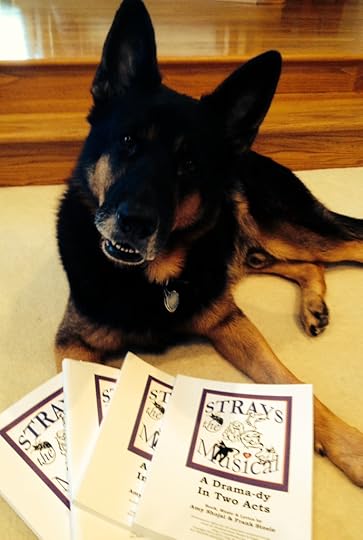Amy Shojai's Blog, page 97
October 16, 2014
STRAYS CAST ANNOUNCED! RESERVE SEATS NOW!
STRAYS CAST ANNOUNCED! RESERVE SEATS NOW!
 The cast of STRAYS has been rehearsing since late September, preparing for the November 6, 7, 8 performances at 7:00 pm at the Honey McGee Playhouse in Sherman Texas.
The cast of STRAYS has been rehearsing since late September, preparing for the November 6, 7, 8 performances at 7:00 pm at the Honey McGee Playhouse in Sherman Texas.
STRAYS is an original show by Amy Shojai and Frank Steele that explores furry foibles from the PETS’ point of view. “All new scripts are written in (forgive us) kitty litter. Working with a cast helped us tighten scenes and refine songs for the best actor/audience performance experience possible,” say Shojai and Steele. “We’re proud to premier the show with this fantastic cast, courtesy of Theatricks and the Honey McGee Playhouse.”
All actors remain onstage and each portrays several feature roles—including human owners—in this hilarious and often moving “drama-dy” that seeks to edu-tain audiences about normal pet behavior that too often gets pets kicked out of the house. In addition, Petco, Natural Balance pet food, and others have donated pet-centric gift baskets (including some waived pet adoption fees to qualified owners) to raise funds for the local Animal Refuge Foundation and Red River SPCA.
“Our pet loving cast ranges in age from kindergarten to mature adults, including several parent/child castings,” say the playwrights. “Many are experienced performers you know from Theatricks and Finley productions, while others are first-time actors.”
The cast of 30 includes Denison performer Avery Hall, and Van Alstyne performers Kate Carson, Charlotte Thomas and Sofia Westmoreland. Sherman performers are Sophia Allen, Jim Barnes, Marty Burkart, Kaitlyn Casmedes, Christina and Jesse Childress, Lew Cohn, Roxy Farrel and her mother Katie Wiley, Kevin Gautier, Ava Gibson, Carolina Guerra and her children Abraham, Eliana and Sofia, Ken Kozak and his daughter MacKenzie, Theresa Littlefield, Brenna Michaelsen, Steven Milward, John and Susan McGinn and their daughter Sarah, Charity Riley and daughter Brynn, and Liam Troncalli.
 STRAYS is co-directed by Steele and Shojai, with assistance from rehearsal pianist Dr. John McGinn and choreographer Kaitlyn Casmedes. In addition, Steven Milward is technical adviser, with Michael Gardner running lights. Brenna Michaelsen and Tobias Scheibmeir share the duties of stage manager.
STRAYS is co-directed by Steele and Shojai, with assistance from rehearsal pianist Dr. John McGinn and choreographer Kaitlyn Casmedes. In addition, Steven Milward is technical adviser, with Michael Gardner running lights. Brenna Michaelsen and Tobias Scheibmeir share the duties of stage manager.
The show is suitable for all ages, and children will especially enjoy the funny songs—just remember that the actors are pretending to be cats and dogs doing what often “hisses” owners off, like scratching, barking, jumping or missing the litter box. Parents of very young or sensitive children should be aware the show briefly addresses the reality of what happens to unwanted pets. “Rest assured, there IS a happy ending!”
The Honey McGee Playhouse seats slightly over 100, and the three performances November 6, 7, 8 are expected to sell out quickly. Tickets are $10 each, and you can purchase tickets at the door or reserve seats online at the Theatricks website by clicking on the STRAYS link on the night you wish to attend.
CLICK HERE FOR THURSDAY, NOVEMBER 6, 7:00 PM PERFORMANCE
CLICK HERE FOR FRIDAY, NOVEMBER 7, 7:00 PM PERFORMANCE
CLICK HERE FOR SATURDAY, NOVEMBER 8, 7:00 PM PERFORMANCE
I love hearing from you, so please share comments and questions. Do you have an ASK AMY question you’d like answered–post in the comments. Stay up to date on all the latest just subscribe the blog, “like” me on Facebook, and sign up for Pet Peeves newsletter. Stay up to date with the latest book give aways, kewl product offers, and appearances related to my THRILLERS WITH BITE!
AMY SHOJAI'S Bling, Bitches & Blood - Pet-centric Writer-icity & Thrillers With BITE!
October 8, 2014
Curing Magic Markers: Acral Lick Granulomas & What to Do
Curing Magic Markers: Acral Lick Granulomas & What to Do

When your pet is so itchy he licks sores onto his legs, what’s a caring pet owner to do? Image Copr. DepositPhotos.com/Quasarphoto
Magic has been miserable, chewing and scratching himself nearly 24/7 for the past two months. We attributed all the itch-icity to bug bites, although he’s on a monthly flea preventative.
Then we noticed he’d begun lick-lick-licking his left “wrist” until the fur wore off, and skin turned raw. Again, we figured he’d had a bug bite or other minor irritation that caused the problem. By keeping it clean and interrupting his licking, the spot healed and fur began to re-grow.

Thick sticky tears from weepy eyes that’s hard to clean away–hair loss around his eyes. The vet suspected “dry eye.” Yikes!
About the same time, his eyes began to water more than usual. This happened right after one of his games of “hose tag” so we figured he’d just had a bit of water irritation. But even as the front leg healed, he began licking the toes on a rear foot, again self-barbering away fur and leaving the area raw. On top of that, the front “wrist” area looked thickened like a large callus even with most fur back in place. The outside base of one ear became sore and itchy.
FLEAS? ATOPY? ACRAL LICK SORES? AUTOIMMUNE DISEASE?!
Now, after writing about many different doggy ailments over the years, I always fear the worst. Our first German Shepherd had such devastating skin disease that at one time, he became nearly bald with itchy sores all over his ears and body, and his skin turned black from saliva stains. He had to eat a homemade diet, be bathed twice a week, and take 14 pills of various kinds every day. He only returned to near-normal when we moved to Texas but was never fully healthy.

Magic’s left front “wrist” with saliva-stained thickened skin–but at least the fur has begun to return and it’s no longer raw.
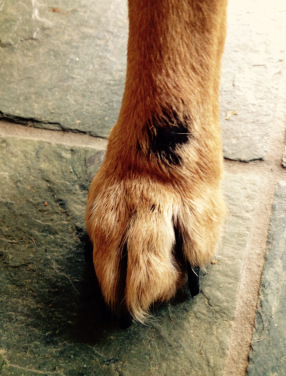
Magic’s left rear paw–he licks the top of the toes, too, but fur has covered that portion up. The dark place is stained hairless tissue–it’s healed, but was bright red and raw.
Magic has always been extraordinarily healthy, so it came as a shock to see some of the same signs that our first dog had suffered. I suspected it could be a couple of things—lick sores are common in German Shepherds—but worried it might even be an autoimmune issue (way scary!). Guessing gets nothing done, and it takes a professional to figure things out. Last week, we took him to the veterinarian to find out what was going on, and how to keep him comfortable.
Now, Magic LOVES the vet—licks all over his face!—but he’s a big dog and won’t allow certain handling. While the veterinarian echoed some of my initial suspicions, a definitive diagnosis required tests in order to prescribe the right meds. So we agreed to leave him for sedation so a skin scrapping of the sores, an ear culture, and a tear test could be done.
MAGIC’S DIAGNOSIS
The good news—it is NOT an autoimmune issue. Whew! More good news—Magic’s tear test was normal, so we’re not dealing with dry eye. While it’s not common, the vet suspected teary eyes were a result of allergies.
More good news—no ear flushing was needed, the inflammation was isolated to the external base of the front of the ear. Again, this was attributed to allergies (probably atopic dermatitis). While in the past, atopy has been defined as “inhalant” allergic dermatitis, today it’s considered more of a contact allergy with paw-pad exposure and absorption of allergens being a big influence. Wow…knowing that could have helped our first dog enormously!
On to the spots on Magic’s paw and leg—and yep, they were diagnosed as lick sores, technically called acral lick granulomas. The skin scraping indicated bacteria was present, too. There are LOTS of causes, from an initial irritation to stress, boredom, and even obsessive-compulsive issues.
WHAT IS ACRAL LICK GRANULOMA?
With acral lick granulomas, the dog incessantly licks a selected area, usually on a lower leg, which creates a raised, hairless ulcerative plaque—almost a callus that surrounds the never-healing sore. The constant licking makes the area itch and can cause secondary bacterial infection. This prompts further licking to relieve the itch, and a vicious cycle is created.
Any dog can be affected, but the condition most commonly affects males older than three years. The syndrome is often seen in large active-breed dogs that demand a lot of owner interaction, such as Golden Retrievers, Labrador Retrievers, Doberman Pinchers, Great Danes, and you guessed it—German Shepherds.
Treatment is difficult in many cases, and some dogs may never be completely cured. Infections may respond to antibiotics, and steroids may temporarily soothe itchiness.
MAGIC’S Rx
Magic was given cephalexin antibiotic, Betagen topical spray for the sores, and low dose prednisolone to calm the whole body itch. The veterinarian says he’ll need to be on the antibiotic for at least two months (probably longer) until both lesions completely heal since often these are deep seated infections—and they could recur down the road. The steroid is low-dose and will be gradually reduced.
The night Magic came home he was still woozy from the sedation. But by the next day and just one round of medication, he already felt so much better! We’re now about five days into the treatment, and with the itchiness calmed, both leg sores have made great progress toward healing, and his eyes no longer water incessantly.
GENERAL RECOMMENDATIONS
In many cases, giving dogs stricken with lick sores more one-on-one time can help reduce boredom and stress. Since I work at home, Magic has attention pretty much all the time, but there has been quite a lot of stress over the past several months due to job changes. Dogs can react to an owner’s stress—so I need to work on handling my own angst-icity!
Dogs that are confined alone for long periods of time tend to have more problems. Some dogs respond favorably when another pet is adopted into the home. Magic has Karma—the jury is out on whether that’s helpful or added stress! The habit may be interrupted in some dogs through the use of veterinary prescribed drugs used in treating obsessive/compulsive disorders. All that, of course, is up to the veterinarian and based on the individual dog’s situation.
Have you ever had a dog that suffered with “lick sores?” How did you manage it? Were the lesions healed, and were there any relapses? What else should I watch for with Magical-Dawg?
I love hearing from you, so please share comments and questions. Do you have an ASK AMY question you’d like answered–post in the comments. Stay up to date on all the latest just subscribe the blog, “like” me on Facebook, and sign up for Pet Peeves newsletter. Stay up to date with the latest book give aways, kewl product offers, and appearances related to my THRILLERS WITH BITE!
AMY SHOJAI'S Bling, Bitches & Blood - Pet-centric Writer-icity & Thrillers With BITE!
October 2, 2014
FOUNTAIN OF HEALTH: SAVE $30 INCREASE #CATS LAP-TIME!
FOUNTAIN OF HEALTH: SAVE $30 INCREASE #CATS LAP-TIME!
 Do your cats drink enough water? Karma-Kat just discovered the LAP OF LUXURY with the NatureSpa UV Fountain, and I couldn’t wait to share this with all my Sweet Peeps!
Do your cats drink enough water? Karma-Kat just discovered the LAP OF LUXURY with the NatureSpa UV Fountain, and I couldn’t wait to share this with all my Sweet Peeps!
I’M THE NEW SPOKESPERSON for the PetHealthyStore.com launching today (YEEE-HAW!) and I love this fountain so much, I negotiated a GREAT DEAL just so I could pass it on to you. Consider this my launch-party-gift to all my Blingy-Blog, Pet Peeves, Facebook & Twitter besties!
I’ve tested and reviewed a LOT of pet water  fountains and figure they’re all pretty much alike. But when they sent me a free NatureSPA to review (NOTHING goes in the store unless I love it!), I was surprised. . . It’s so good, I updated my books to include the recommendation.
fountains and figure they’re all pretty much alike. But when they sent me a free NatureSPA to review (NOTHING goes in the store unless I love it!), I was surprised. . . It’s so good, I updated my books to include the recommendation.
It usually retails for $69.99, but you’ll get $30 off just by inputting the code AMYFOUNTAINSAVE30 in the shopping cart.
I’ve never seen a fountain like this! In fact, Karma pushed me out of the way to get a taste before I could toss the packing material away.
CUTTING EDGE HYDRATION
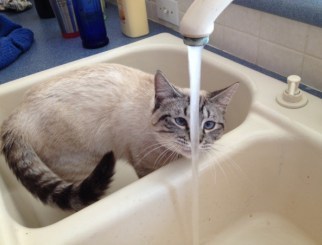 What’s so different? NatureSPA uses UV Light to sterilize the water and kill bacteria that make it taste bad. That reduces the icky slime that’s so hard to clean. This is the same UV sterilization system used in some human medical procedures.
What’s so different? NatureSPA uses UV Light to sterilize the water and kill bacteria that make it taste bad. That reduces the icky slime that’s so hard to clean. This is the same UV sterilization system used in some human medical procedures.
But do cats and dogs really need a fountain? Magic makes do with a huge water bowl on the floor—well, and the occasional slurp from the toilet (yuck!). Cats toilet-taste too, given the chance. And I betcha y’all have a cat or two that LOVES lapping water from the faucet, like Karma!
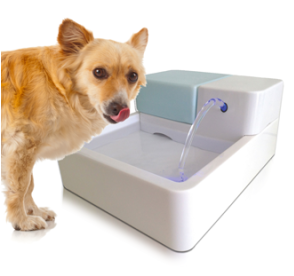 NatureSPA is designed so water spouts outward, enticing cats (or small dogs) to take a taste just like your dripping faucet. Like other fountains, it has replaceable charcoal filters that get rid of any nasties.
NatureSPA is designed so water spouts outward, enticing cats (or small dogs) to take a taste just like your dripping faucet. Like other fountains, it has replaceable charcoal filters that get rid of any nasties.
CATS HAVE A DRINKING PROBLEM!
Cats evolved as desert creatures. Water was so scarce, they got most of their water from munching prey. Even though modern cats rarely munch critters and the water bowl stays full, Kitties still don’t drink as much as they should. And that can lead to health problems.
In fact, 84% of cat’s body weight is water which fuels the body, lubricates tissues, regulates temperature, carries nutrients through the bloodstream, aids digestion and removes waste. Water is so important that only a 15% water loss causes deadly dehydration, so it’s vital to keep cats (and dogs) drinking healthy.
DO YOUR CATS DRINK ENOUGH? WANT TO INCREASE “LAP TIME?”
CLICK HERE to get $30 off the BEST FOUNTAIN EVAH!
Enter AMYFOUNTAINSAVE30 in the shopping cart.
To drink, cats curl their tongue forward into a spoon shape, and lapping creates a column of liquid they swallow. Dogs curl their tongue BACKWARDS like a ladle to lift water to drink.
Both cats and dogs love this fountain because movement aerates water, mixes it with air so it TASTES GOOD! When water tastes good, cats and dogs drink more. When they drink more, water keeps them healthy especially when dealing with urinary tract issues.
I was really surprised that it was so quiet. There’s no motor hum so it won’t scare your cats—and for me, acts like a water-splashing lullaby, complete with a bluish nightlight. Kitty won’t care, but I think it’s pretty!
 Even better, there’s a 1-year warranty, and a 30-day money back guarantee. I’ve had the motors in fountains burn out when the water level drops too far, so the auto-shutoff feature is value added. This is the ONLY fountain that auto-shut-off.
Even better, there’s a 1-year warranty, and a 30-day money back guarantee. I’ve had the motors in fountains burn out when the water level drops too far, so the auto-shutoff feature is value added. This is the ONLY fountain that auto-shut-off.
NatureSPA UV Fountain holds 1.8 quarts of water – that’s 58 ounces – but you can get a larger reservoir for multiple pet homes. I like that the fountain looks modern and is made from human-grade ABS plastic.
The Naturespa UV Fountain usually sells for $69.99. But I love this fountain so much, I wanted to share it with my pet-lovin’ friends.
 Simply go to Pethealthystore.com and enter the coupon code AMYFOUNTAINSAVE30 in the shopping cart to save $30.00. That’s 42% off! You pay only $39.99 for a $69.99 fountain.
Simply go to Pethealthystore.com and enter the coupon code AMYFOUNTAINSAVE30 in the shopping cart to save $30.00. That’s 42% off! You pay only $39.99 for a $69.99 fountain.
How do you get your pets to drink healthy amounts of water? Do tell!
I love hearing from you, so please share comments and questions. Do you have an ASK AMY question you’d like answered–post in the comments. Stay up to date on all the latest just subscribe the blog, “like” me on Facebook, and sign up for Pet Peeves newsletter. Stay up to date with the latest book give aways, kewl product offers, and appearances related to my THRILLERS WITH BITE!
AMY SHOJAI'S Bling, Bitches & Blood - Pet-centric Writer-icity & Thrillers With BITE!
October 1, 2014
How to Prepare If Pets Outlive You
How to Prepare If Pets Outlive You
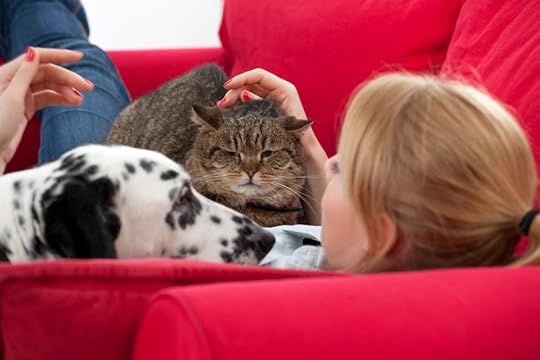
Image Copr. DepositPhotos.com/photomac
This week, the pet community is reeling from the tragic and sudden death of two heroes, animal behaviorist Dr. Sophia Yin and Cat Writers Association president Dr. Lorie Huston. Dr. Yin left behind her beloved dog Jonesy, while my friend Lorie is survived by 6 special needs rescue cats. CWA members are networking to re-home Lorie’s cats.
Neither expected to have their pets outlive them. Do you have plans for your special pets?
In the past, elderly readers have contacted me to ask about setting up care options for her pets should she die before them. Although healthy and with every intention to stick around for the foreseeable future, at age 72 she wanted to be prepared, should something unexpected happen. But as we’ve seen, even younger people can have the worst happen.
Sadly, orphaned pets often end up in shelters or destroyed by the surviving family members, when nobody feels able or willing to care for the left-behind fur-kid. The adult pet hasn’t a clue why she’s suddenly gone from a loving home and lap, to a scary metal cage.
How to Prepare For Pets After Your Death
What can caring owners do to prepare for the worst, if death, disability or age takes away a pet’s home? Will family and friends rally to find loving homes for all of the orphaned animals?
Your family and friends, veterinarian contacts and church relationships may be eager and willing to offer a place for your pet should you die before them. Maybe you have brother-dogs that would pine away if separated, or special needs cats that requires extra medical care. Often, a simple promise among friends will be sufficient. Ideally, the animals already know and get along with the new owner—because missing you will be as tough for them as for your human family.
In today’s changing world, though, good intentions and a promise made years before may go out the window should the person’s own situation change. For instance, maybe your friend has other pets that won’t accept your animals, or living arrangements/finances have changed. For peace of mind, it’s best to make formal arrangements in your will and try to address every eventuality.
LEGAL CONSIDERATIONS
Legal restrictions won’t allow a beloved pet to actually inherit from your estate because critters are themselves defined as property. But you certainly can set up trusts for the care of the pet, and name a specific person who will receive those funds so that they can take the critter into their care for the remainder of its life. Once you find persons willing to take your pet, consult with an attorney about the proper paperwork necessary to make a legal and binding arrangement.
There also are “pet retirement homes” or “sanctuaries” that might be able to take your pets. Organizations that give pets a home for life, though, have limited openings. A fee is involved that pays for the care, and this may be set up in your will or other legal document.
David Congalton and Charlotte Alexander wrote the book, “When Your Pet Outlives You” which contains sample legal forms, names of pet law specialists, addresses of pet retirement homes and sanctuaries throughout the U.S., a report on all relevant state statutes, important court decisions affecting people and their pets, and precise details on how to set up a pet trust.
The Humane Society of the United States offers a free brochure called Providing For Your Pet’s Future Without You. It suggests you find at least two responsible friends or relatives and provide them with emergency information for short-term care.
Also ensure your neighbors know how many pets you have and how to contact emergency care givers. Carry a wallet “alert card” with this information and post “in case of emergency” notices on your doors or windows. The pamphlet includes sample legal language for wills and suggestions how to choose a permanent care giver for your animals in case of your death.
Once these emergency issues are in place, you’ll have peace of mind. That allows you to relax and enjoy making the most of the time you have with your special animal companions.
May you have many more loving years with your special companions. Meanwhile, I’m making my own emergency arrangements — just in case — for my Magical-Dawg, Seren-Kitty and Karma-Kat, while my heart breaks for Lorie and her furry wonders left behind.
I love hearing from you, so please share comments and questions. Do you have an ASK AMY question you’d like answered–post in the comments. Stay up to date on all the latest just subscribe the blog, “like” me on Facebook, and sign up for Pet Peeves newsletter. Stay up to date with the latest book give aways and appearances related to my THRILLERS WITH BITE!
AMY SHOJAI'S Bling, Bitches & Blood - Pet-centric Writer-icity & Thrillers With BITE!
September 30, 2014
BRAVO & KONG DOG & CAT FOOD RECALLS!
BRAVO & KONG DOG & CAT FOOD RECALLS!

Image Copr. DepositPhotos.com/cynoclub
On September 26, 2014, Bravo of Manchester, CT began recalling select lots of Bravo Turkey and Chicken pet foods for dogs and cats because they could be contaminated with Salmonella.
The recalled product was distributed nationwide beginning on November 14, 2013 to distributors, retail stores, internet retailers and directly to consumers. Products being recalled include:
RAW FOOD DIET BRAVO! TURKEY BLEND FOR DOGS AND CATS
Bravo! Blends All Natural Chicken Blend diet for dogs & cats
Premium Turkey Formula BRAVO Balance RAW DIET
Bravo! Blends All Natural Chicken Blend diet for dogs & cats
In addition, as a precaution, the following chicken products are being withdrawn: all sizes (2 lb., 5 lb. and 10 lb.) of Bravo Chicken Blend(s), Bravo Turkey Blend(s), Bravo Balance Chicken Balance and Bravo Balance Premium Turkey Formula frozen raw diet products with best used by dates between June 20, 2016 and September 18, 2016.
Details with “use by” dates of affect products and what you should do can be found on the company website at www.bravopetfoods.com or by calling 866-922-9222 Monday through Friday 9 am to 5 pm ET.
KONG AUSSIE STICKS DOG TREATS RECALLED
In addition, Kong Aussie Sticks dog treats were also recalled this week by the manufacturer, JAKKS Pacific of Walnut, California due to possible contamination with mold.
 The products being recalled have the following item numbers:
The products being recalled have the following item numbers:
Item 75559
Item 75560
And these “Best Before” dates:
1/30/16
1/31/16
The product can be returned to PetSmart for a full refund. For further info, contact JAKKS Pacific at 877-875-2557, Monday through Friday from 7:30 am to 5:00 pm PT. Kong can be reached at 303-216-2626.
I love hearing from you, so please share comments and questions. Do you have an ASK AMY question you’d like answered–post in the comments. Stay up to date on all the latest just subscribe the blog, “like” me on Facebook, and sign up for Pet Peeves newsletter. Stay up to date with the latest book give aways and appearances related to my THRILLERS WITH BITE!
AMY SHOJAI'S Bling, Bitches & Blood - Pet-centric Writer-icity & Thrillers With BITE!
September 25, 2014
Cold Protection for Hot Dogs & Cats
Cold Protection for Hot Dogs & Cats

THIS would be Karma’s answer…if Magic would let him snuggle! Image Copr. Drago_Nika/DepositPhotos.com
Do your fur-kids enjoy the cold weather? Or do they use shivery days to campaign for more lap time? How do YOUR pets stay warm during shivery days?
I know it’s only Fall and warm weather will hang around for another month here in North Texas. But the cold is just around the corner. Magical-Dawg loves seeing his breath and would spend lots more time outside–if his humans could stand it! Seren-Kitty, though, is a heat seeking kitty and has staked out several warm nap spots throughout the house. Karma-Kat showed up during cold weather last year, and has a distinct preference for sunny spots.
What about your cats and dogs? Paws up, or down, to winter?
Sure, they have fur mufflers to keep icy winter blasts at bay. But pets risk cold weather dangers just as much as people do, and maybe even more. Because most folks have a warm place to retreat, and not all cats and dogs have this luxury. Others, like Magical-Dawg, may not have the sense to come in from the cold when they’d rather play in the frigid temps.
I grew up in Northern Indiana and hated the cold–I still do, although I do appreciate seeing a white Christmas (but from the view inside the house, LOL!). My thriller LOST AND FOUND takes place during a freak blizzard that puts a little boy and his service dog at risk for freezing to death. The main character September offers cold weather pet tips in a radio interview as the book opens. And the sequel HIDE AND SEEK continues the story, with the Maine Coon kitty character lost outside in freezing temps. Yep, I include “real life” risks in the fiction but when it comes to your cats and dogs, be sure you know all the furry de-tails to keep ‘em safe (sorry, couldn’t resist!).

Small dogs and thinly furred canines need help staying warm. Image Copr. Pingvin121674/DepositPhotos.com
HOW PETS STAY WARM
Dogs and cats don’t benefit from gi-normous dog houses, and even the garage (unless it’s heated!) may not be protective. Instead, they curl up in small shelters that can be warmed by their own body heat.
Shelter from the wind and precipitation is vital. Fluffed fur traps warm air next to the skin in an insulating layer, but wind strips that away.Getting wet makes the cold worse, when fur can’t fluff to hold warm air. A twenty-mile-per-hour wind makes forty-degree weather feel like 18 degrees, more than enough to cause frostbite in an unprotected cat or dog.
Adult dog and cat body temperature ranges from about 100 to 102.5 degrees F. Puppies and kittens, though, have trouble maintaining body temperature. Newborn pups and kittens must pile together in furry bundles, or snuggle next to Mom–and if left alone, they can develop hypothermia and die even in mild weather. Huddling together shares warmth and reduces wind loss of heat, and shivering generates heat.
Shorthaired pets have less protection but even fuzzy critters are at risk. Thinly furred areas or body parts exposed to the wind or that come in contact with the icy ground have little protection from the cold. And the little dogs may develop potty issues because they simply hate getting cold and would rather “go” where it’s nice and warm–inside!
Pets conserves heat by diverting blood circulation from the ear tips, toes and tail to protect the vital organs in the central part of the body. But reduced circulation to these extremities increases the chance for frostbite.

Cats like Seren prefer to experience winter through the window. Image Copr. yanikap/DepositPhotos.com
WHAT IS FROSTBITE?
Tissue is 90 percent water. When frozen, cells rupture when the water expands just like ice cubes overflowing the tray. The resulting damage—termed frostbite—can be painful and severe.
Frostbite turns the skin pale white, gray or blue. Fur may hide the damage but you’ll notice pets limp from frozen toes, frozen ear tips or tails droop, and the skin will be very cold, hard, and nonpliable.
Redness, blisters, and serious infection develop days later. If it’s really severe, the affected tissue turns leathery and insensitive to sensation. If not removed surgically, those areas fall off. When I worked as a vet tech in Eastern Kentucky, we often had pet patients that lost parts of ears, toes and in one memorable case, an Elkhound lost his curled tail. All cases of frostbite need veterinary attention after first aid. Details for treating frostbite and hypothermia can be found in The First Aid Companion for Dogs & Cats.
WHAT IS HYPOTHERMIA?
While frostbite causes discomfort and damage to the extremities, hypothermia happens when overall body temperature falls below normal. In people hypothermia is defined as body temperature lower than 95 degrees, and treatment is vital to survival. When body temperature falls too low in pets, they can die.
Mild hypothermia happens if body temperature drops to between 95 to 99 degrees F. Pets act a bit sluggish and lethargic, and you’ll see muscle tremors and shivering. Moderate hypothermia is more serious when the temperature falls to 91 to 95 degrees. Severe hypothermia is body temperature 90 degrees or less, and is an emergency—take your pet to the veterinarian as soon as possible! Pets lose the ability to shiver if their body temperature falls to 90 degrees or below, so that’s a warning sign. They may fall unconscious, and rescue breathing may be necessary.
The best protection is to provide shelter from the wet and cold. Bring outdoor cats and dogs inside during severe cold. Why not snuggle together, share body heat and protect each other safe from Old Man Winter’s dangers?
So how do you protect your pets from cold weather? Do tell!
I love hearing from you, so please share comments and questions. Do you have an ASK AMY question you’d like answered–post in the comments. Stay up to date on all the latest just subscribe the blog, “like” me on Facebook, and sign up for Pet Peeves newsletter. Stay up to date with the latest book give aways and appearances related to my THRILLERS WITH BITE!
AMY SHOJAI'S Bling, Bitches & Blood - Pet-centric Writer-icity & Thrillers With BITE!
September 22, 2014
Audition for STRAYS, Channel Your Inner Pet!
Audition for STRAYS, Channel Your Inner Pet!
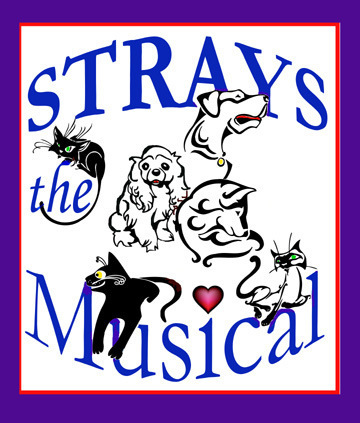 Come channel your inner cat and dog and audition for STRAYS, THE MUSICAL on Tuesday and Wednesday, 6:00-9:00 pm on September 23-24 (callbacks September 25) at the Honey McGee Playhouse in Sherman Texas.
Come channel your inner cat and dog and audition for STRAYS, THE MUSICAL on Tuesday and Wednesday, 6:00-9:00 pm on September 23-24 (callbacks September 25) at the Honey McGee Playhouse in Sherman Texas.
STRAYS explores furry foibles from the PETS’ point of view. The actors give voice to a variety of cat and dog characters in this hilarious–and often moving–musical review “drama-dy” that seeks to edu-tain audiences about normal pet behavior while honoring the bond we share with them.
STRAYS seeks up to 25 actors, singers and dancers, from kids to adults. Families (parents and kids) are encouraged to audition together. Rehearsals are at the Honey McGee, Sunday through Thursday evenings beginning September 28 with performance three nights only November 6, 7, 8 at the Honey McGee. The show will be rehearsed in individual scenes, so actors won’t be needed at every rehearsal. Families will be scheduled at the same time frame.
No experience is necessary. Auditions consist of filling out a form, singing a short selection of your choice (or simple music will be provided), reading scenes from the script, and demonstrating your best cat and/or dog character. A pianist will be available for you to bring sheet music, or bring your own CD for your song and/or dance audition. Dancers may be asked to learn a short routine.
There are up to 20 individual speaking/singing parts; you may be cast to play more than one role or given additional lines and/or solo verses in company songs. STRAYS includes music styles from pop rock to blues, calypso, gospel and musical theater, and even rap, country-western, jazz, and Celtic. The show will be performed with full orchestration via CD recording.
Featured roles for men include BOY PUPPY (age 13-20), CHOW HOUND (adult bass/baritone), OLD DOG (adult tenor), LUCKY CAT (adult, talk-singer), DOG RAPPER (any age), and HUMAN-OWNER (adult).
Featured roles for women include GIRL KITTEN (soprano/actor age 13-20), QUEEN CAT (soprano/adult), OLD CAT (non-singing, mature), CAT RAPPER (any age), PETS TRIO (any age, close harmony), DANCE CAT (solo-modern/ballet), and HUMAN-OWNER (adult).
Several featured roles may be played by either males or females of any age, and include BLUESY DOG, BEGGING DOG, WISH CAT, and GOSPEL CAT (all mid-range solos), EGO DOG (non-singing), and DANCE PETS (any age).

THE SECRET GARDEN show just closed at the Honey McGee Playhouse, and this gorgeous set will be re-purposed and used for STRAYS.
STRAYS will be co-directed by Frank Steele and Amy Shojai, with assistance from rehearsal pianist Dr. John McGinn and choreographer Kaitlyn Casmedes. In addition, Steven Milward is technical adviser. Anyone interested in technical/crew positions is encouraged to attend.
For further information contact Amy Shojai, (amy@shojai.com, 903-868-1022). You can also fill out an audition form online at the Theatricks website.
I love hearing from you, so please share comments and questions. Do you have an ASK AMY question you’d like answered–post in the comments. Stay up to date on all the latest just subscribe the blog, “like” me on Facebook, and sign up for Pet Peeves newsletter. Stay up to date with the latest book give aways and appearances related to my THRILLERS WITH BITE!
AMY SHOJAI'S Bling, Bitches & Blood - Pet-centric Writer-icity & Thrillers With BITE!
September 17, 2014
Prepare Pets for Disaster–Then Pray You Don’t Need It!
Prepare Pets for Disaster–Then Pray You Don’t Need It!

Bucharest, Romania – October 2, 2012: A fire fighter holds a cat, after saving it from a burning block of flats in Bucharest. — Photo Copr bizoon/DepositPhotos.com
September is Disaster Preparation Month, and it’s important to have a disaster plan not only for yourself when Mother Nature throws a tantrum, but also to keep your pets safe. Whether you must deal with tornadoes, floods, landslides, typhoons, wildfires or other emergencies, there’s a rule that we must always PLAN FOR THE WORST.
And then pray it doesn’t happen.
A recent Pet360.com survey revealed 13% of pet owners had been through a disaster or evacuation with pets, and of those, 12% had been separated from their fur-kids. I don’t know about you, but I’d go CRAZY if I was separated from Magic, Seren or Karma at such a time! Other findings:
46% do not have an emergency plan in place for their pets.
Of those who do have a plan, only 40% practice it with their pets.
Less than 35% have an emergency kit for their pets.
63% do not have Pet Alert stickers in their windows.
TOP TIPS FOR PET PLANS
Watch news and weather reports. When weather turns ify, bring all pets into the house so that you won’t have to search for them. Make sure all dogs and cats are wearing collars and up-to-date identification. If you have nothing else handy, use a felt-tip marker and write your phone number and name on the pet’s tummy.
Designate a “safe room” in the house to confine pets until the all clear. Many homes in North Texas don’t have basements or storm cellars. An internal room without windows, often a bathroom without windows, can be a good option. At my house, the cats get stuffed into cat carriers and placed inside the pantry situated under the stairs. It’s big enough that the humans and Magical Dawg can fit inside, too.
Teach pets NOW to go to their “safe room” by practicing and rewarding with tasty treats, favorite games or anything that really floats their boat. Cats often hide during strange weather so make sure you have a way to find them.
EVACUATION!
If you must evacuate, take your pets along. It may be days before authorities allow you to return home.
Red Cross shelters currently prohibit pets, except for certified service animals. In the wake of the Katrina deluge, efforts are underway to make some changes that accommodate furry family members. Until/unless those changes come about, if you’ve got to evacuate, find a hotel, friend, or other accommodations in advance that will let you bring your dogs and cats. Hotels that ordinarily prohibit pets may make exceptions during times of emergency evacuations so always ask.
Attach the phone number and address of your temporary shelter, if you know it, to the pet’s collar tags. You can buy temporary tags or put adhesive tape on the back of your pet’s ID tag, adding information with an indelible pen. Write directly on a flat nylon collar or halter to make it easy for a stranger to read the information.
Have a pet evacuation emergency kit handy that contains pet food, medications, cat litter, vaccination/health certificates and veterinary contact information. You may need proof of vaccination to be admitted to shelters. Be sure your kit contains a three-day supply of all the pet essentials. If easily packed, take an extra towel or blanket for each pet. Don’t forget sturdy leashes, harnesses, carriers or X-pens for safe confinement. Not sure what else to pack? Check out Pet360’s top 10 pet emergency kit items.
Most facilities will require your cats and dogs to be under your control, and may also require proof of current vaccination. Include a favorite comfort toy or treat, the pet’s food and can opener if needed, and don’t forget water—one quart per cat-size pet per day (more for big dogs) is a good rule of paw. One of the pheromone spray products such as Comfort Zone/DAP for dogs or Feliway for cats can help relieve the stress of being in a strange environment.
Have plenty of plastic bags and newspapers as well as containers and cleaning supplies to help deal with pet waste. Puppy training pads or Depends undergarments work well.
Prepare for the unthinkable, too. Include current photos of your pets in case they get lost, and bring a first-aid kit to care for possible injuries. Include disposable latex gloves, sterile dressings, antibiotic towelettes and ointment, eyewash, thermometer, and any prescription medications your pets need. You can find more specifics in “The First-Aid Companion For Dogs & Cats.”
Your evacuation kit should also include a cell phone, flashlight, extra batteries, battery powered radio, map of area, whistle/air horn to signal for help, and matches in a waterproof container. Keep a list of emergency numbers with your phone, including a pet emergency clinic number and shelters that may temporarily house animals. Keep your car tank filled with at least half a tank at all times.
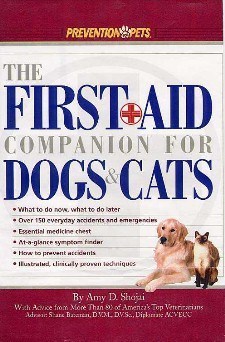 The Federal Emergency Management Agency (FEMA) provides information and relief for human victims of disaster, and also offers more information about pets here. The ASPCA also offers great disaster preparation information for owners at http://www.aspca/org/BePrepared.
The Federal Emergency Management Agency (FEMA) provides information and relief for human victims of disaster, and also offers more information about pets here. The ASPCA also offers great disaster preparation information for owners at http://www.aspca/org/BePrepared.
This evening September 18 at 7 pm ET, the ASPCA will bring together various disaster experts for a Google Hangout to talk about how to prepare for disasters with pets. The virtual event will be moderated by GMA’s weather anchor Ginger Zee, featuring experts from ASPCA, FEMA and USDA, as well as special animal guests who were disaster survivors. Download the free ASPCA App which includes a check-list of actions to take before, during and after a major storm.You can find more info and RSVP at this link: http://bit.ly/1BpYSrb.
Be ready for Mother Nature’s “what if” surprises now and prepare for the worst. I pray you’ll never need this information.
Have you ever gone through a disaster or evacuation with your pets? What do you wish you’d known, or would do differently? Please share!
I love hearing from you, so please share comments and questions. Do you have an ASK AMY question you’d like answered–post in the comments. Stay up to date on all the latest just subscribe the blog, “like” me on Facebook, and sign up for Pet Peeves newsletter. Stay up to date with the latest book give aways and appearances related to my THRILLERS WITH BITE!
AMY SHOJAI'S Bling, Bitches & Blood - Pet-centric Writer-icity & Thrillers With BITE!
September 11, 2014
The Dog Heroes Of September 11
The Dog Heroes Of September 11
Our pets are heroes to us every day, in so many ways, but the service dogs and their human partners who served selflessly in the aftermath of the 9-11 tragedy deserve special recognition.
With heartfelt thanks…May we never again need your service in such a capacity, but bless one and all for such a wonderful gift!
I love hearing from you, so please share comments and questions. Do you have an ASK AMY question you’d like answered–post in the comments. Stay up to date on all the latest just subscribe the blog, “like” me on Facebook, and sign up for Pet Peeves newsletter. Stay up to date with the latest book give aways and appearances related to my THRILLERS WITH BITE!
AMY SHOJAI'S Bling, Bitches & Blood - Pet-centric Writer-icity & Thrillers With BITE!
September 8, 2014
Puppy Play! The Good, The Bad & the Dangerous
Puppy Play! The Good, The Bad & the Dangerous
 It’s here! *cue the trumpets, tail wags & happy howls!*
It’s here! *cue the trumpets, tail wags & happy howls!*
COMPLETE PUPPY CARE is now available for your puppy-licious reading pleasure. I’ve included a brief excerpt below about how to tell when GOOD puppy play tips over into DANGEROUS games. That’s just the tip of the furry info, though. Please share the news about this book with all your puppy and dog loving peeps.
WANT A FREE PDF TO REVIEW?
COMPLETE PUPPY CARE includes more than two-dozen SQUEEE! cute puppy pictures (including Magical-Dawg as a baby), plus all the puppy must-knows. Those who subscribe to my PET PEEVES newsletter (see the right side of the blog) got the news early–and TEN folks won a free copy in exchange for posting an honest review. I’m nervously nail-biting until those get posted!
I’ll make the same offer here–post in the comments for a chance to review a free PDF copy of the book (the first 10 requests get the book!). AND…tell me the link of your review once it’s posted and I’ll send you a free copy of your pick of MY CAT HATES MY DATE or MY DOG HATES MY DATE quick tips guide as a thank you. 
ABOUT COMPLETE PUPPY CARE…
Nothing beats a cute puppy for love, but proper puppy care and training prepares you and your new dog for a healthy and long life together. This up to date new guide provides a “Puppies 101” packed with veterinary facts, health care advice, how-to tips, and fascinating information about:
Choosing, training and communicating with your new puppy
Pros and cons of purebred versus shelter/rescue sources
Understanding common behavior problems and how to prevent them
Food, grooming and humane training recommendations
Tips for introducing your puppy to adult dogs, cats, babies and kids
The latest veterinary recommendations for preventive care
How to recognizing common health issues, and what to do
First aid and home remedies that save you money—and your puppy’s life!
More than two-dozen SQUEE! cute puppy pictures
Canine legends, myths and fun puppy facts including: Why puppies drink from the toilet, why dogs act guilty, reasons dogs hump your leg, and more!
COMPLETE PUPPY CARE empowers you with all the information necessary for your puppy to grow up into the happy, healthy dog you both deserve.
“Just Kidding” During Play
Dogs use exaggerated behaviors, called meta signals, to tell other dogs all action that comes after is not serious but a game. For instance, the play-bow is a butt-in-the-air with front-end down position where the pup’s forelegs dance back and forth to invite play. When your puppy first play-bows, he’s
telling you that any growls or wrestling that comes after are meant as fun and games.
Adult dogs often “pretend” to be subordinate to a puppy—with play bows or rolling on the back—to build up the pup’s confidence and invite him to play. This “just kidding” game allows lower-ranking pups to practice being in charge with play bites, mounting behavior, and wrestling games. Once the
play is over, the higher-ranking dog again assumes his more “mature” behavior that tells the pup to respect his leadership.
BAD VS GOOD PLAY—KNOWING THE DIFFERENCE
Dogs of all ages enjoy playing. Behaviors for fighting and fun are similar, but you must know how to tell the difference between aggression and play-acting. Watch for “meta signals” which tells participants that whatever comes after is meant in a “play” context.
Dogs commonly drop toys on your feet or lap to solicit a game, and offer toys to other dogs in the same way. A play bow—the dog sticks his butt and tail into the air, and bows forward on lowered forelegs that dance side to side—is the classic signal and invitation for the games to begin. Often, the
“fighting” behaviors seen during such games will be exaggerated to indicate play, or the “fight” behavior sequences may be jumbled.
Play includes inhibited mouth-open bites often aimed at the legs and paws of other dogs. Dogs also paw and bat each other without force to hurt. In appropriate play, all the dogs willingly participate. If you suspect one of the dogs doesn’t like the activity (one dog repeatedly tries to escape or hide),
gently separate the pair to see if they go back for more. If the play session was too rough, one will sneak away.
Inappropriate play results in one or more dog frightened, hurt, or overwhelmed. Bully dogs always end up on top, while in appropriate play you’ll see dogs take turns chasing and pinning each other during wrestling. Mouthing aimed primarily at the head or neck, or uninhibited bites means play has gotten out of hand. You’ll hear yelps from the bitten dog.
Consistent play up on hind legs may indicate problems. Ongoing mounting, clasping and thrusting also can lead to problems, as can resting of paws, heads or whole bodies across other dog’s shoulders to intimidate or achieve social status.
Growls don’t usually indicate problems, but play can be so exciting that the action escalates into aggression. Listen for louder, lower pitched growls,and be prepared to break up the session before they get too aroused.
***
Okay now, what about YOUR puppies and dogs? How do they play? Is it polite, taking turns, or is there some bully behavior involved? At my house, Magical-Dawg’s best play buddy is Karma-Kat and that involves a whole new set of signals.
Don’t forget–post your comment for a chance to review a free copy of the book!
I love hearing from you, so please share comments and questions. Do you have an ASK AMY question you’d like answered–post in the comments. Stay up to date on all the latest just subscribe the blog, “like” me on Facebook, and sign up for Pet Peeves newsletter. Stay up to date with the latest book give aways and appearances related to my THRILLERS WITH BITE!
AMY SHOJAI'S Bling, Bitches & Blood - Pet-centric Writer-icity & Thrillers With BITE!


